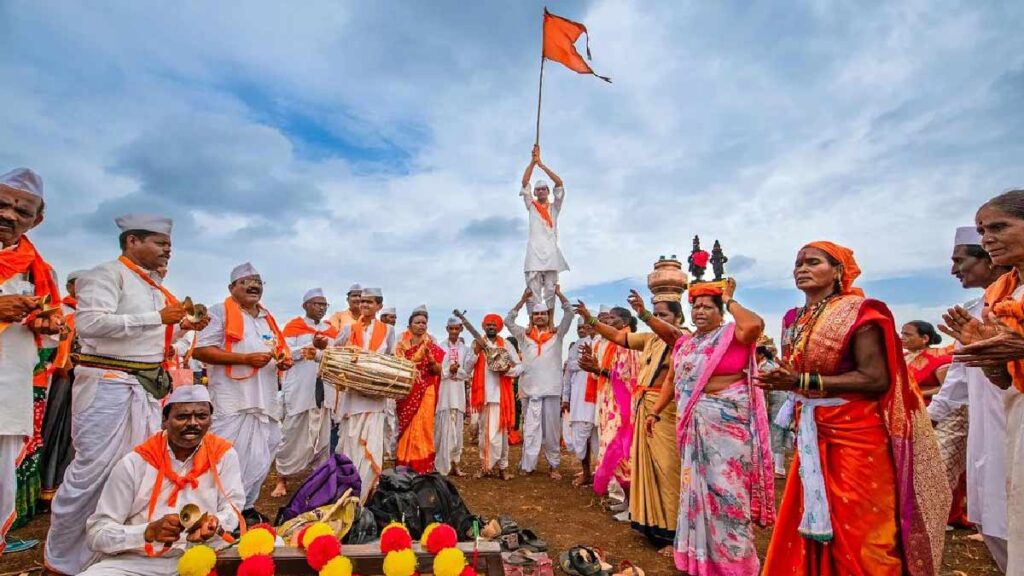The Pandharpur Wari is an annual spiritual pilgrimage in Maharashtra, India, where hundreds of thousands of devotees (called Warkaris) walk over 200–250 kilometers to the Vithoba Temple in Pandharpur. Dedicated to the deity Vithoba—a form of Lord Vishnu—this 21-day journey embodies the egalitarian ethos of the Bhakti movement and honors the legacy of revered saints like Dnyaneshwar Maharaj and Tukaram Maharaj. Recognized as one of the world’s largest and oldest continuously observed pilgrimages, the Wari is a cultural and spiritual cornerstone of Maharashtra.
Historical Origins: Myths and Legacy
The origins of the Wari are intertwined with Maharashtra’s Bhakti tradition. While no single theory is definitive, key narratives include:
- Vitthalpant’s Legacy: The pilgrimage is often linked to Vitthalpant (father of Dnyaneshwar Maharaj), who is said to have initiated regular visits to Pandharpur in the 13th century. However, historical records suggest the Wari’s formalization occurred later, around the 17th–18th centuries.
- Role of Bhakti Saints: The saint-poets Dnyaneshwar Maharaj (13th century) and Tukaram Maharaj (17th century) popularized devotion to Vithoba through their compositions (Dnyaneshwari and Abhangs). Their spiritual journeys to Pandharpur inspired the Wari tradition, though the organized procession of carrying their paduka (sandals) began later.
- Palkhi Tradition: The practice of carrying saints’ paduka in palanquins (palkhis) was institutionalized in 1685 by Narayan Maharaj, Tukaram’s youngest son. This ritual symbolizes the saints’ eternal presence guiding devotees.
Colonial-Era Reorganization
The Wari underwent significant restructuring in the early 19th century under Haibatravbaba Arphalkar, a noble in the Scindia court and ardent devotee of Dnyaneshwar. His contributions include:
- Introducing the Dindi system: Organized groups of pilgrims (Dindis) for better logistics.
- Formalizing the procession structure with palanquins, horses, and a fixed schedule.
- Standardizing rituals like morning aarti and devotional singing.
Contrary to colonial narratives framing public health interventions as purely altruistic, scholar Manjiri Kamat notes that British measures (e.g., cholera vaccinations, pilgrim taxes) were partly driven by revenue and control motives. Nevertheless, these steps improved sanitation and safety for pilgrims.
The Pilgrimage: Rituals and Journey
Key Features
- Starting Points:
- Dnyaneshwar’s Palkhi departs from Alandi (Pune district).
- Tukaram’s Palkhi begins in Dehu (Pune district).
- Duration: 21 days, culminating on Shayani Ekadashi (11th lunar day of Ashadha’s bright fortnight).
- Route: Pilgrims walk ~250 km, joined by smaller palkhis from towns like Solapur and Nasik. The final ritual involves bathing in the Chandrabhaga River (a tributary of the Bhima) before entering the Vithoba Temple.
Dindis: The Backbone of the Wari
- Each Dindi comprises 50–500 pilgrims, often from the same village or community.
- Responsibilities include arranging food (prasad), lodging, and medical aid. Drummers and flag-bearers lead the groups, chanting hymns like “Vitthal Vitthal!” and “Gyanba-Tukaram.”
- Over 200 registered Dindis participate, reflecting Maharashtra’s social diversity.
Cultural and Social Impact
- Unity in Diversity: The Wari transcends caste, class, and gender barriers. Devotees wear simple white attire and tulsi necklaces, symbolizing equality.
- Devotional Arts: The pilgrimage keeps alive the Abhangs (devotional poetry) of Tukaram and Dnyaneshwar, sung collectively during the march.
- Economic Boost: The event supports local economies through food stalls, lodging, and donations. Mathas (monasteries) and NGOs provide free meals (mahaprasad).
Modern Management and Challenges
- Administration: Managed by hereditary trustees (Chopdars) and the Alandi Devasthan Trust. The schedule is published months in advance, detailing daily stops like Theur, Saswad, and Pune.
- Environmental Concerns: Recent initiatives promote plastic-free Wari and river cleanup drives to protect the Chandrabhaga.
Corrections from Earlier Account
- Paduka Transportation (2020): The sandals were driven via vehicle, not flown, due to pandemic restrictions.
- Distance Clarification: The exact walking distance varies by starting point (e.g., 250 km from Alandi, 200 km from Dehu).
- Dindi Origins: While Haibatravbaba formalized Dindis, smaller pilgrim groups likely existed earlier.
- Shayani Ekadashi Date: Falls in June–July, but the Bhima River reference is corrected to Chandrabhaga River at Pandharpur.

